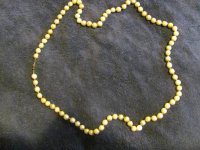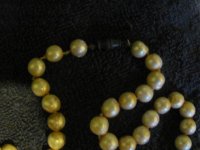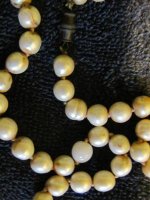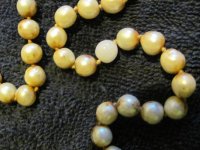 My boyfriend found these on the bottom of the lake while fishing this past weekend. 84 pearls, hand knotted, blemishes, indents, and chipping. They have an orangish [/ATTACH] [/ATTACH] tint on some of them. All diff looking, and some have started to chip, one has no top layer on it, and is still shiny, and when I rub them together it leaves a white mark and I can wipe it off. They do feel gritty along my tooth. It has a barrel clasp and is heavy. Not sure if they are fake or real, and how long they have been sitting on the lake floor. Can a real pearl loose its top layer? The one that is missing all of it, is whitish and looks like it has a rough surface, but is has an earadesance? shiny layer. HELP...........can anyone help with these pictures and have any ideas on wether or not they are real?
My boyfriend found these on the bottom of the lake while fishing this past weekend. 84 pearls, hand knotted, blemishes, indents, and chipping. They have an orangish [/ATTACH] [/ATTACH] tint on some of them. All diff looking, and some have started to chip, one has no top layer on it, and is still shiny, and when I rub them together it leaves a white mark and I can wipe it off. They do feel gritty along my tooth. It has a barrel clasp and is heavy. Not sure if they are fake or real, and how long they have been sitting on the lake floor. Can a real pearl loose its top layer? The one that is missing all of it, is whitish and looks like it has a rough surface, but is has an earadesance? shiny layer. HELP...........can anyone help with these pictures and have any ideas on wether or not they are real?You are using an out of date browser. It may not display this or other websites correctly.
You should upgrade or use an alternative browser.
You should upgrade or use an alternative browser.
Pearl necklace found fishing.....are they real?
- Thread starter moosedlsl
- Start date
Caitlin
Well-known member
No need to post more than once.
Those look like they were once pearls- maybe freshwater. Really cheap clasp. Really terrible shape.
They were thrown in the lake for a reason.
Those look like they were once pearls- maybe freshwater. Really cheap clasp. Really terrible shape.
They were thrown in the lake for a reason.
Pearl Dreams
Pearl Enthusiast
Or pseudo-freshwaters? The one bead without nacre looks like glass.
Caitlin
Well-known member
Yes it does. I think I see too much variation for it to be pseudo- but it is not easy to guess. That could be a MoP bead and thus the necklace was once an akoya.
lisa c
Perpetual Pearl Student
But guys, nacre doesn't dissolve in water, remember? Just chlorine and other acids, right? Unless...maybe tannic acid is the culprit here?
Since I'm still learning, what are pseudo-freshwaters coated with? The same stuff as Majoricas? Powdered fish scales or powdered pearls?
Moosedlsl, where are you located? and have you tried to clean these up so you can really see them? There are threads about how to clean pearls. Just dont dip them in chlorine bleach yet. The experts are probably right, that's a lot of experience behind these opinions, but I'm still learning and I'd like to know what you'll find. Why not satisfy yourself so you don't have doubts? The quickest thing I'd do is take a utility knife and scrape near the thread hole. If it peels right off without effort it's a coated bead, cheap as can be.
Also, real pearls should not powder when rubbed together.
However, Real People do throw away good pearls, that's why I'm asking where you are, or where the lake is. My ex-mother-in-law threw a beautiful pearl necklace into a lake in a fit of anger many years ago. Also a diamond ring. I'm with Marilyn Monroe on this one - I never could blame a piece of jewelry for anything bad.
Since I'm still learning, what are pseudo-freshwaters coated with? The same stuff as Majoricas? Powdered fish scales or powdered pearls?
Moosedlsl, where are you located? and have you tried to clean these up so you can really see them? There are threads about how to clean pearls. Just dont dip them in chlorine bleach yet. The experts are probably right, that's a lot of experience behind these opinions, but I'm still learning and I'd like to know what you'll find. Why not satisfy yourself so you don't have doubts? The quickest thing I'd do is take a utility knife and scrape near the thread hole. If it peels right off without effort it's a coated bead, cheap as can be.
Also, real pearls should not powder when rubbed together.
However, Real People do throw away good pearls, that's why I'm asking where you are, or where the lake is. My ex-mother-in-law threw a beautiful pearl necklace into a lake in a fit of anger many years ago. Also a diamond ring. I'm with Marilyn Monroe on this one - I never could blame a piece of jewelry for anything bad.
Last edited:
Pearl Dreams
Pearl Enthusiast
I've seen fake freshwater strands that have variation in the shapes of the pearls to make them seem more real, but the shapes do repeat at intervals.
Modern era imitation pearls are beads of glass, plastic or shell dipped in "essence d'orient" (ground fish scales in a sort of lacquer). That could peel off, leaving the bead.
Modern era imitation pearls are beads of glass, plastic or shell dipped in "essence d'orient" (ground fish scales in a sort of lacquer). That could peel off, leaving the bead.
Amanda
Member
- Joined
- Jan 25, 2012
- Messages
- 521
My ex-mother-in-law threw a beautiful pearl necklace into a lake in a fit of anger many years ago. Also a diamond ring. I'm with Marilyn Monroe on this one - I never could blame a piece of jewelry for anything bad.
didn't Za Za Gabor say something like, "I've never hated a man enough to give him back his diamonds"?
I am in the Adirondacks, NY. These were found in the Sacandaga resivoir. I know nothing about pearls. So are fakes worthless? This does look old.....the knots and all. How do you tell for sure if it is a glass bead, or a real pearl underneath? They are all totally different, and the coloring I am guessing is because of the oils in the water. I know the clasp looks cheap, but something is telling me that they have been in there a while.Thanks for all your opinions.
Caitlin
Well-known member
I think lakes could have things that would destroy the nacre. Even salt water pearls once out of the shell, dissolve back into the ocean. I can't think of many happy scenarios for throwing a pearl necklace into a lake unless it was a gift to the Lady of the Lake.
The necklace, judging from its clasp and size probably was very, very inexpensive to begin with. I'd be inclined to give it back to the lake and go get some really pretty and inexpensive freshwater pearls...
The necklace, judging from its clasp and size probably was very, very inexpensive to begin with. I'd be inclined to give it back to the lake and go get some really pretty and inexpensive freshwater pearls...
Pearl Dreams
Pearl Enthusiast
Yes, a good reason to buy some consolation pearls! 
lisa c
Perpetual Pearl Student
I'm learning... Mel Fischers treasure ship Atocha(?) with the buckets of pearls keeps nagging me for some reason, all the pearls that survived for centuries - in saltwater, though. Maybe someone can tell us if tannic acid would eat pearls? Any vegetable matter decomposing in the reservoir could produce tannic acid and even if not highly concentrated like swamps and glades, maybe a necklace buried in the vegetation would be in a highly acidic squish.
I love that region. Some of the wells in the finger lakes region in NY state have a sulphurous smell and taste. You can't discount other mineral contents, iron for one; there are all sorts of springs there.
Why not clean em up, then give them a scrape? This is just for fun, the 'pros knows', and the cheap clasp generally points to inexpensive pearls, if they were pearls. Inexpensive pearls are still enjoyable, if they clean up nicely for you.
Fakes can be fun, but they can wear out pretty fast if not well made. Some fakes, like older Majoricas can be pretty and durable with good care, but pearls are our passion, so...
One other thing, some stones (quartz-like, etc) also feel gritty rubbed across teeth.
I love that region. Some of the wells in the finger lakes region in NY state have a sulphurous smell and taste. You can't discount other mineral contents, iron for one; there are all sorts of springs there.
Why not clean em up, then give them a scrape? This is just for fun, the 'pros knows', and the cheap clasp generally points to inexpensive pearls, if they were pearls. Inexpensive pearls are still enjoyable, if they clean up nicely for you.
Fakes can be fun, but they can wear out pretty fast if not well made. Some fakes, like older Majoricas can be pretty and durable with good care, but pearls are our passion, so...
One other thing, some stones (quartz-like, etc) also feel gritty rubbed across teeth.
Last edited:
Caitlin
Well-known member
Good point. They were in closed chests and somehow got deposits on them. I wonder how many did survive and if some were unsalvageable.
lisa c
Perpetual Pearl Student
I wonder, also. I also wonder who got to assess those pearls, don't you? Maybe google at the library tomorrow...
Thanks for sharing all your information, you guys, plus the quips and literary references!
Thanks for sharing all your information, you guys, plus the quips and literary references!
Last edited:
lisa c
Perpetual Pearl Student
Moosedlsl, as you can see this rambling helps us learn, we haven't forgotten you. The fastest route is to clean the strand then scrape not next to the clasp, but one or two beads down from there.
I hope they clean up, turn out to be pearls and make a romantic story.
My mother-in-law gave one 24" strand to the maid and threw the rest in a lake near Miami. Appalling. I wanted to dredge the lake. She felt I missed the point of her story.
I hope they clean up, turn out to be pearls and make a romantic story.
My mother-in-law gave one 24" strand to the maid and threw the rest in a lake near Miami. Appalling. I wanted to dredge the lake. She felt I missed the point of her story.
Last edited:
Bacca
New Member
Is that a magnetic clasp? It would be unusual to see that kind of clasp on good quality, genuine pearls, especially if it's base metal. You could try cleaning the clasp to see if you can raise precious metal, or quality marks, moosedlsl, but I'm thinking the water has pretty much destroyed what was not a very valuable item originally.
It's true that natural (all nacre, not nacre coated) pearls can peel. When that happens, though, what's underneath looks like a pearl, as opposed to a bead. Your necklace is a bead of some sort that was coated. You have a fun find! You could clean it up and wear it as a conversation piece.
Lisa, my guess is the thing with these pearls is they were coated, not solid nacre. If the coating was nacre, remember we're talking about a substance that can be damaged by perspiration. Given some time, I think destroying a thin layer of nacre (or essence d'orient) would be a piece of cake for lake water.
It's true that natural (all nacre, not nacre coated) pearls can peel. When that happens, though, what's underneath looks like a pearl, as opposed to a bead. Your necklace is a bead of some sort that was coated. You have a fun find! You could clean it up and wear it as a conversation piece.
Lisa, my guess is the thing with these pearls is they were coated, not solid nacre. If the coating was nacre, remember we're talking about a substance that can be damaged by perspiration. Given some time, I think destroying a thin layer of nacre (or essence d'orient) would be a piece of cake for lake water.
lisa c
Perpetual Pearl Student
It looks like a barrel screw-in clasp.
Lagoon Island Pearls
Well-known member
- Joined
- Dec 8, 2009
- Messages
- 2,143
Was the clasp engaged, or disengaged when found?
Please forgive my morbidity, but an engaged clasp might indicate a crime scene.
Please forgive my morbidity, but an engaged clasp might indicate a crime scene.
lisa c
Perpetual Pearl Student
God, Dave . I was thinking the same thing. Isn't it awful? But I guess it needs to be asked. Awful as it is, if someone's missing and they're in the reservoir...
I was wondering what the effects of decomposition would be on pearls. It's a shame. It'd be much better if someone just was mad and threw them out. Or if they took them off to go swimming and always clasp them, and just dropped them over the side of a boat by accident.
I was wondering what the effects of decomposition would be on pearls. It's a shame. It'd be much better if someone just was mad and threw them out. Or if they took them off to go swimming and always clasp them, and just dropped them over the side of a boat by accident.



